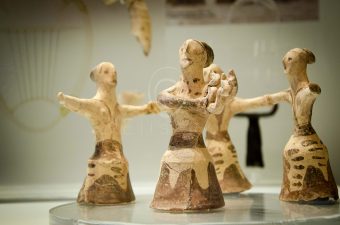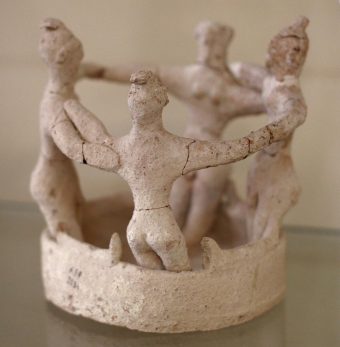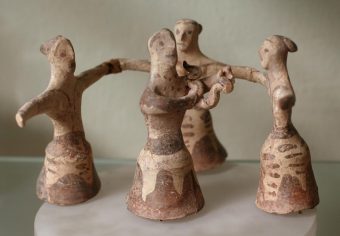Fashion in Minoan Crete
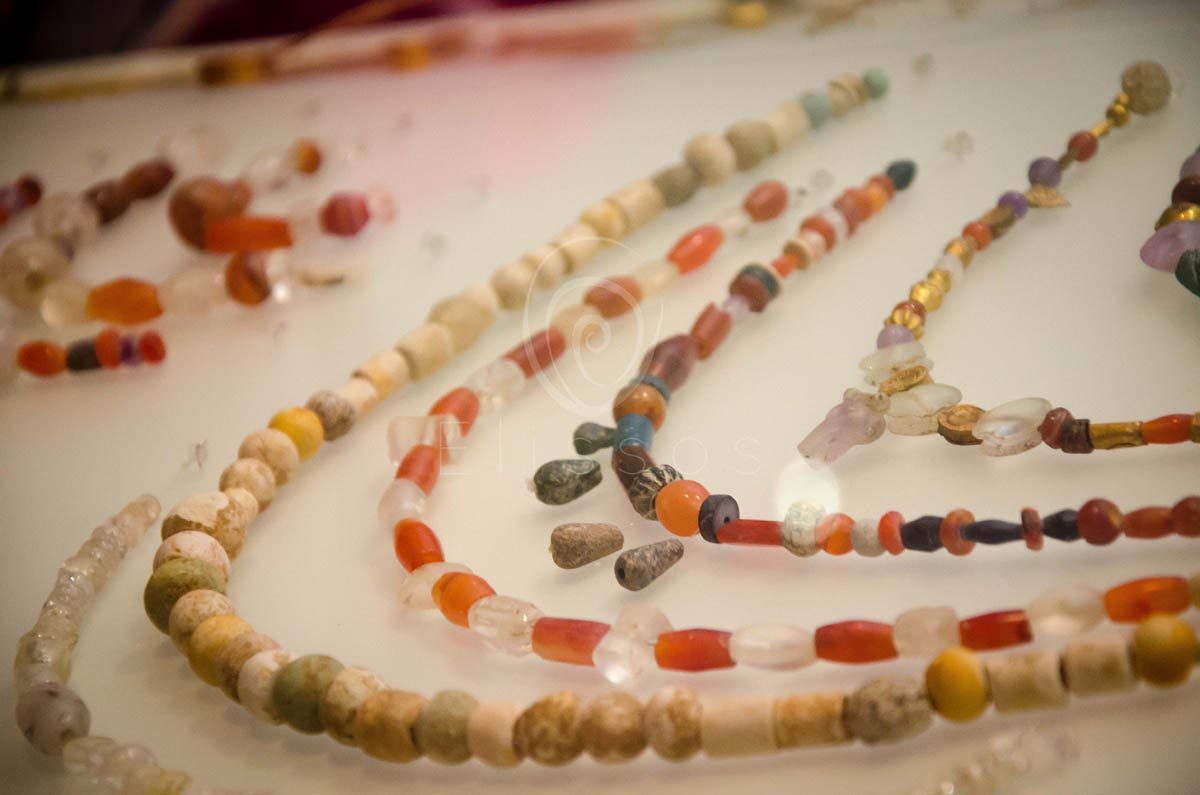
Fashion in Minoan Crete has a substantial meaning as it explores the artistic side of this elevated civilization.
This ‘fashionable’ article unleashes the creativity of the Minoans, who so eloquently designed different garments for men and women. We will be looking into how Minoan men and women dressed and accessorized as well as what athletes and dancers used to wear. However, let us first introduce you to this exceptional culture.
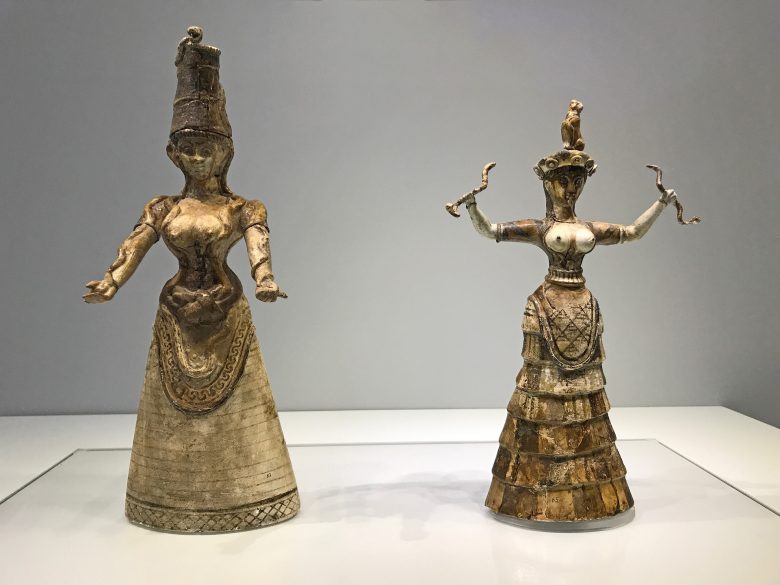
Fashion in Minoan Culture
The fact that the Minoans had created the first remarkable civilization is something that also emerges from the clothes they wore. Looking at the Minoan frescoes and the Minoan figurines that have been found in Crete, in ancient Greece (Sparta, Athens) as well as in ancient Egypt, and Mesopotamia, we see that the Minoans are the first in the world who cut and sewed clothes to the measurements of a person.
Already from 2000-1500 BC, they made different clothes for men, women, priests, etc. Therefore, the Minoans are the first to create tailored clothing and fashion. In other words, we see that the Minoans had a multi-complex culture and more advanced not only than what the previous societies have had but also than what the societies that followed in Greece and Italy since they seem to wear a variety of garments, which are not only luxurious but also elegant and complex.
We do not know exactly what these Minoan garments were called then. Nonetheless, it is obvious that from them come those that today we call: skirt, dress, cardigan, salwar, shorts, robe, sandals, boots, belt, etc. It should be noted that the rest of the Greeks (Athenians, Spartans), and Romans, during the Minoan era, as well as many years after the so-called Minoan Empire wore clothes that were something like today’s bed linen called a tunic.
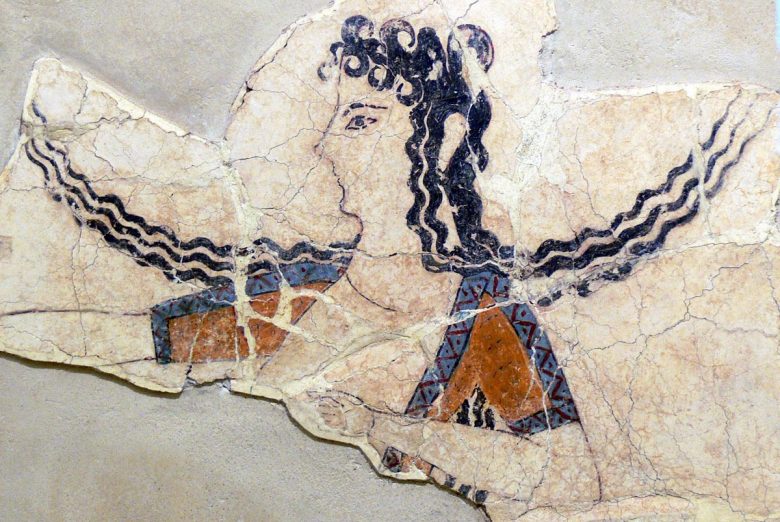
Garments for Minoan Women
The Minoan women’s clothing, as it appears from the description in Homer’s Iliad, as well as the frescoes and figurines found in Knossos, consisted at least of the following, woolen or linen, garments.
Colorful & Elaborated Skirts
They were just like today. These skirts had pleats, ribbons, trimmings, and fringes. There were also multi-layered, bell-shaped skirts with a series of horizontal ruffles, which gradually widened until they reached the ground.
Tight Handweaved Corsets
They appear something like the later cardigans. They usually had short sleeves, were fitted, and open at the front. At the same time, they contained a mechanism of breast augmentation, however, the Minoans simply left their breasts uncovered, as a fertility symbol.
Thick Breast Cloths
The breastplate was either opaque or cobweb fabric that covered the breasts. If it was a requirement, itwas supported with laces around the neck. Sometimes mythological beings wore a breastplate as a distinctive item of clothing.
Beautifully Embellished Belts
It appears like that of today’s Cretan traditional costume, which is, long, wide, and richly decorated. It was tied around the waist and tight to emphasize it and is a symbol of distinction.
Fancy Quilted Aprons
Typically it was either made of a single or double-layer (front and back) and went over the skirt. It was tied at the waist with a strap. The single-layered one was similar to that of the Cretan traditional costume. The double was two aprons joined in the middle to protect the skirt on the seats. The apron was richly decorated with embroidery and adorned the outfit.
Garments for the Lower Body
‘Anasyrida’ is the name of the low-rise bloomer, in Greek. It looked something like a sack, with only two holes in the bottom, for the legs to go through. These undergarments were worn by Minoan women, around 3000 BC and were redeveloped in the 19th century and soon became a symbol of women’s rights because early activist Amelia Bloomer wore drawers long enough to stick out from under her dress.
Air Flowing Shorts
They were like today’s athletic shorts which were formed by the double Minoan apron joining the center of the backside apron with the center of the front side with the crotch. It was not until the 1930s, when shorts started to be worn for casual comfort (e.g. outdoor and athletic activities) by both men and women. However, it was still taboo to wear shorts outside certain activities, whereas for Minoan women, it was part of their attire thousands of years ago.
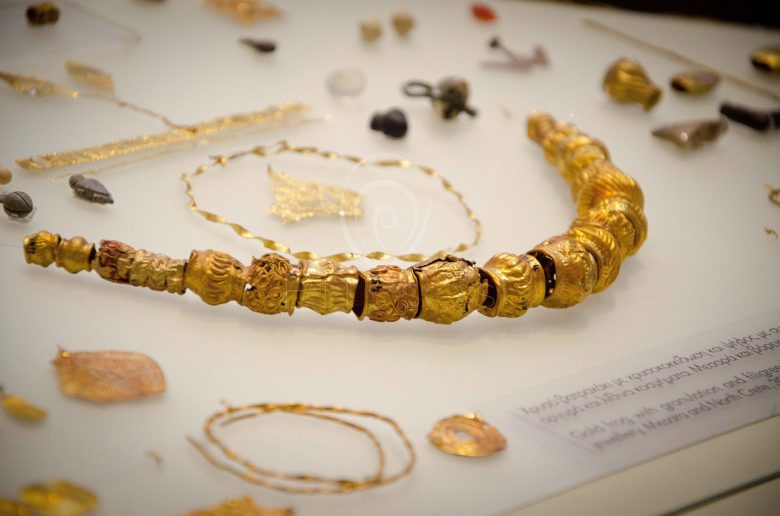
Accessories for Minoan Women
In Minoan Crete, women’s clothing was made from a wide variety of materials, such as linen, leather, and wool. They decorated them with bright colors and patterns, with ribbons at the ends, bows, delicate veils. The jewelry, made of gold, metal, stone, or bone, were sewn on. Particularly important are the figurines findings, mainly those that come from the sanctuaries of eastern Crete from the Middle Minoan Era (2000-1600), but also the seal stones, jewelry and objects, which were related to the care and beautification of the body.
Tailored Shoes
Minoan women’s shoes were sandals, which were fitted to the foot with relatively high straps and short boots. Although, the ‘ancient Greek’ sandal trend is still relevant nowadays, with big fashion brands bringing them to the forefront during their fashion shows, it all started with the Minoans. Nonetheless, inside the houses and sanctuaries, the Minoans were always barefoot.
Precious Jewelry
The Mioans made jewelry out of a variety of materials: gold and precious or semi-precious stones, such as silver, agate, amethyst, crystal, amber, most of which must have been imported. The drop-shapes, macaroons, or spherical beads (‘psifoi’) were made from the above materials but also from faience and a blue glass mass, which as a cheaper material could replace gold. They also had many kinds of jewelry: armbands, necklaces, bracelets, and ankle bracelets. Minoans wore these decorative items for personal adornment, and they were either attached to the body or the clothes.
Sophisticated Cosmetics & Hairstyling
Minoan women used to take care of their face, body, and hair, apply natural cosmetics, and have special hairstyles. The excavations shed light on the fact that Minoan women instinctively knew that olive oil was itself one of the most effective beauty secrets for their skin and hair. They created essential oils, which they extracted from various parts of plants such as rose, nutmeg, fennel, anise. Other ingredients used to make perfumes and ointments were coriander, honey, and wine. Perfume-making workshops have also been located in the palace of Zakros and Mycenae, where in addition to the jars, there was a heating system, catalogs of aromatic plants and amphorae, the vases for storage and, as it turned out, jars for transporting perfumes abroad.
As for make-up, the women applied white powder on their face, while painting their lips, cheeks, nails and ear lobes red. They also intensely painted their big eyes with dark paint. All dyes came from plants. As they showed particular interest in their appearance, they chose extravagant hairstyles. Sometimes the hair was gathered in a bun and small curls fell on the forehead and ears. Other times, they adorned their long and thin curls with hairpins, beads, and clips often in the shape of a flower. They often complemented their hairstyles by adding ribbons, nets, diadems, and even hats in various shapes, sometimes with buckles and tiaras.
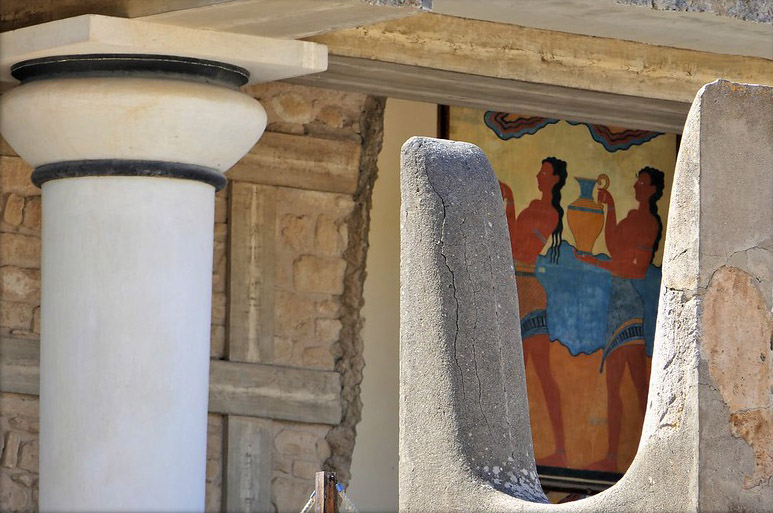
Garments for Minoan Men
From the description in Homer’s Iliad as well as from the frescoes and statuettes that were excavated in Knossos, it appears that the Minoan men were looser in their clothing than the Minoan women. However, they dressed in an impressive, elegant, and complex way. Homer characterizes them as well-groomed and polished, with gleaming, clothes and even cut and sewn to their measurements. In particular Minoan menswear, consisted of at least the following garments:
Decorative Loincloths
The ‘zoma’, which was a wide strip of cloth like a belt with fringes and beads at one end. With the ‘zoma’ they wrapped the body from the waist down to the thighs forming a skirt. The ‘zoma’, which is the earliest forms of clothing, in the Minoan era was worn in rituals, gymnastic demonstrations, at home, in hunting, etc. Basically wherever the requirement was light clothing.
Basic Long Tunics
Usually, that was a short-sleeved tunic, made in white or in other colors with a lightweight fabric. It was a one-piece dress, something like the current robe or gown. They wore it in their formal appearances, sacrificial ceremonies, shrines, etc.
Embroidered Short Tunics
The short tunic or the Greek ‘kontochi’ of the Cretan traditional costume, is the ancestor of the blazer, vest, and sleeved jacket. The Minoan men had no idea that they had designed the base of today’s formal menswear!
Custom-Made “Pericarps”
A special, luxurious category was the pericarps, which would emphasize the body shape letting it stand out. The type of these transparent fabrics is evident in Minoan frescoes of Crete. These fabrics were made of very fine yarn or were mesh, while the possibility of using fine silk yarn has been suggested by some scholars. The male pericarp was a fitted dressy upper garment, similar to today’s blouse.
Formfitting Cloth Belts
Men’s belts are characterized by how tight fabric was tied around their waists. However, the very thin waist, which appears in the Minoan depictions, is probably an artistic convention. It probably does not correspond entirely to reality. They often decorated their belts richly with fringes or beads on the ends. On the belt, the Minoan men supported a small sword or a knife, something found in Cretan folks wear clothing as well.
Lightweight Cloaks
The men’s shorts was a short cloak like today’s shorts. They wore it in rituals and gymnastic demonstrations and they formed them by joining the double Minoan apron, between the legs.
Stylish Hoses
The low-waisted hose called ‘anissyrida’ in ancient Greek was both men’s and women’s clothing. They formed a long skirt, joining, between the legs with two holes, so that the legs could pass through there. Today, the hose is part of the traditional Cretan folkswear clothing for men. People on other Greek islands in the Cyclades and the Dodecanese as well as in Cyprus would also wear it.
Winter Wear
During the Minoan era, there would also be coats (men’s cloaks, capes) for the winter months, which simply have not been depicted.
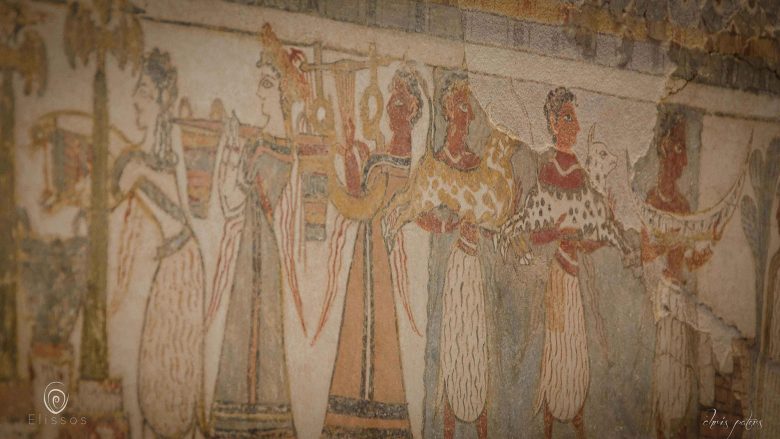
Accessories for Minoan Men
According to Homer, Minoan men in ritual practices appear with a knife in the waist belt. This resembles what the Cretans wear in their traditional costumes as well. Moreover, it is also something that can be seen in the figurines found in Knossos. Cretan merchants traveled to the Eastern Mediterranean to procure gold, copper, and ivory. In return, they offered oil, wine, and aromatic oils. The palace workshops processed these materials with great care, creating works of art unsurpassed in terms of quality and technique.
Fine Jewelry
Minoan men wore rings, mainly made of gold with mythological and other representations on them. Jewelry such as earrings, bracelets, rings, necklaces (‘periapta’, ie jewelry hung around the neck with a chain, often as an amulet and beads), pins, and headpieces, were necessary to complement the appearance of men and women at any formal event.
Custom Footwear
The Minoans appear in some performances barefoot, and in others with sandals. The sandals were adjusted to the foot with relatively high straps and more rarely they were seen in boots. The word “sandal” itself is of pre-Greek origin, it might even be Minoan. Athletes, hunters, and soldiers usually wore boots.
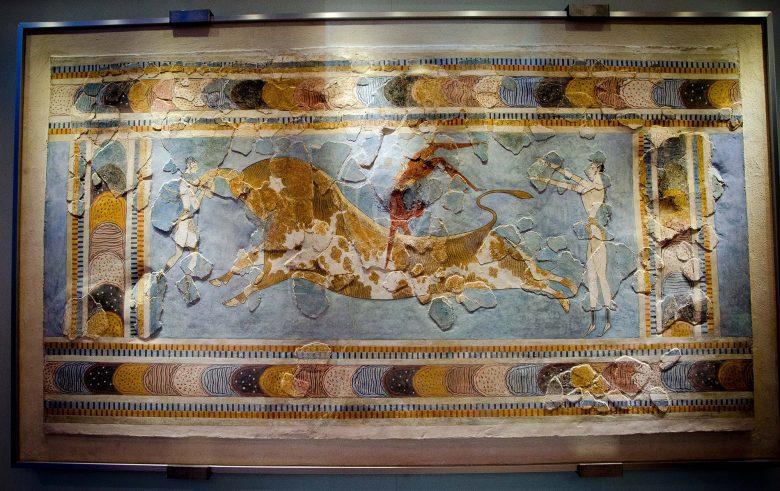
The Fashion of Minoan Athletes
The information we have about the clothes of the athletes of Minoan Crete comes from the bullfighting performances and the boxing scenes. The sportswear was simple, thus facilitating the movements of the athletes. It consisted of the so-called Minoan cloth belt that resembles today’s swimwear and a very narrow belt that supported the waist of athletes. Athletes usually had bare feet but sometimes wore soft shoes with slightly raised toes or leather sandals with straps.
The frescos of the bullfights from Knossos depict, that female and male athletes are together at the same time during the religious sport event. Therefore, religious sportswear was common to both sexes. For this very reason the bodies of the female athletes are symbolically not much different from the male athletes. The gender distinction in this mural is indicated only by the different colors used to depict the skin of the two sexes. Female athletes, however, wore jewelry and had more intricate hairstyles.
The Fashion of Minoan Dancers
Homer in the Iliad (Rhapsody S 590 –605) says, that Hephaestus had designed at the bottom of Achille’s shield a dance similar to the one that was once choreographed by Daedalus in Knossos and was taught by Ariadne, the daughter of Minos, “on her dancefloor”. He says that in this dance the young girls and boys of Crete, dance it sometimes in a circular way and sometimes facing each other. It had an intense rhythm, where the dancers sometimes spin all together with speed and agility. Sometimes forming two groups in opposite rows, just like today’s circular traditional Cretan dances. This is also among the oldest descriptions of Minoan ritual dance.
Homer mentions that the Minoan girls wore fine and linen clothes. While the Minoan boys wore glossy tunics and that used oil to achieve a shine. Homer also mentions that the Minoan girls wore wreaths on their heads. While the Minoan boys put a knife with gold in the middle wrapped around their wastes. This is something that shows in the clay figurines found in Knossos, as well as in other parts of Crete.
At Elissos Travelling Philosophy, we love to design experience bringing together the past, the present, and the future. Subscribe to our Newsletter to learn about our newest activities and tours and let us create your exclusive unique experience in Crete!
Bibliography/ Article Sources:
Metropolitan Museum of Art in New York City

